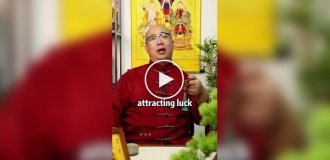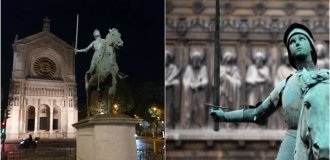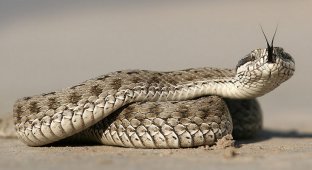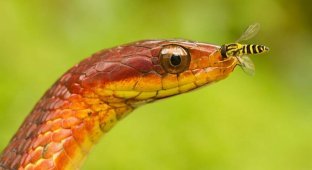I wondered what kind of snakes there are in our lovely Moscow region. I myself caught grass snakes more than once as a child, but I never met others. There are about 2,500 species of snakes on the planet, of which about 400 are poisonous. As I understand it, the most dangerous and only poisonous one is the viper (it’s in the photo below). I compiled a material, maybe someone will be interested in reading it.

Already
Snakes are distinguished from other snakes by their “yellow ears” - pronounced markings on the head, often yellow, but sometimes white and orange. Females are larger than males, sometimes reaching up to 1.5 meters, but most often the size is no more than a meter. It feeds mainly on live frogs, rodents and, less commonly, fish. The enemies of snakes are storks, birds of prey and some mammals.
It tames well and tolerates captivity. In Ukraine and Belarus, there are frequent cases of snakes being domesticated (to kill mice).
Not aggressive at all. At the sight of a man, he flees for his life. When caught, it first actively defends itself: it hisses and throws its head forward, which has a terrifying effect on many enemies. If this does not help, he vomits the recently eaten food and pretends to be dead. Rarely bites. For humans, the bite poses virtually no danger.
Snakes are excellent swimmers, they can stay under water for more than half an hour, but the Pheasant can stay under water many times longer - it is only 15 cm long, and is rarely allowed into burrows.
The mating season begins in April - May. In July - August, female grass snakes look for where to lay their eggs: in humid and warm places. Heaps of humus, old straw, fallen leaves are ideal for this; damp moss, rotten stumps and mouse holes are also suitable. In October - November they crawl into various holes and crevices in the ground, where they spend the winter. A pheasant spends the winter in a fist.
The common snake is widespread throughout Europe, with the exception of the polar regions, in the southern regions of Siberia to Lake Baikal and in the south of the Far East.

copperhead
Copperheads (lat. Coronella) are a small genus of the colubrid family, including only 3 species, living in Europe, northwestern Africa (Morocco, Algeria and Tunisia) and southern Asia (India), although three more African species were recently included in it . There is only one species found on the territory of Russia - the common copperhead (lat. Coronella austriaca).
The body length reaches 70 cm, the tail is 4 - 6 times shorter than the body. The smooth dorsal scales are diamond-shaped or hexagonal in shape. The ventral scutes have noticeable keels that form ribs along the edges of the abdomen. The anal shield is divided into two, rarely into three. The intermaxillary shield is strongly wedged between the internasal ones. There are 19 scales around the middle of the body, 150-182 scales along the belly in males and 170-200 in females, and 40-70 pairs of subcaudal scales. In the first vertical row it has two (rarely one) parietal scutes, in the second - 2 - 3. The nostril is located between two nasal scutes, the preorbital one (rarely two), the infraorbital one is absent (sometimes it is replaced by a small scute lying between the second and third upper labial scutes or above the third), postorbital scutes - two.
The copperhead is clearly distinguished from other European snakes by the presence of a dark stripe passing through the eye and transverse stripes or spots on the body. The color of its back varies from gray to yellow-brown and brown-copper-red, with reddish-brown tones predominant in males and brownish in females. On the upper side of the body there are 2 - 4 rows of spots elongated across, sometimes merging into stripes (which can be very weakly expressed and almost unnoticeable). On the back of her head she has two brown spots or stripes that unite with each other. The belly is gray or steel-blue to brown-red, with dark blurry spots and specks or a dark gray stripe in the middle. The iris of these snakes' eyes is usually red. A dark stripe stretches from the nostril through the eye and the corner of the mouth to the neck.
It lives throughout almost the entire territory of Europe (except Ireland, most of Great Britain, Northern Scandinavia, the central and southern part of the Iberian Peninsula and the islands of the Mediterranean Sea) to western Kazakhstan and the Caucasus, as well as northern Iran. The main part of the range is occupied by the nominative subspecies, the range of which in the north within Russia reaches the Tula and Ryazan regions. Single finds are known from the Moscow region. The southern Pyrenees and the island of Sicily are inhabited by the subspecies C. a. fitzingeri (Bonaparte, 1840), differing from the nominative in smaller size and the presence of few dorsal spots.
Copperheads prefer forested clearings, sunny edges, dry meadows and clearings in various types of forest, avoiding damp places, although they swim well. They rise into the mountains to a height of up to 3000 m above sea level, inhabiting rocky steppe areas with xerophytic vegetation. Their refuges are burrows of rodents and lizards, voids under stones and the bark of fallen tree trunks, and cracks in rocks.
This snake leads a diurnal lifestyle, but sometimes emerges from its hiding places at dusk and even on clear moonlit nights. For several years it does not change its individual areas.
The active season lasts about 0.5 years. The copperheads leave for the winter in September - October. And 1 - 1.5 months before this, they have from 2 to 15 cubs 12.5 - 17.5 cm long. This is the result of spring copulation (in May), but mating can also occur in the fall. In this case, the female gives birth to cubs the following spring (the sperm remain until spring, stored in the female’s seminal receptacles). In the search for a partner, secretions from the cloacal glands play a special role. During the process of copulation, the male holds the female in the neck area with his jaws, wrapping his body around her body. The eggs are retained in the female's body until the embryos are almost fully developed (ovoviviparity). Cubs are born in thin egg shells, which rupture soon after birth, and young individuals immediately begin an independent life. Sexual maturity occurs in the third year of life.
Copperheads feed predominantly (almost 60%) on lizards (facultative saurophagy), in particular on spindles and sand lizards, less often (up to 5% of occurrence) on other small vertebrates (mice, voles, shrews and chicks of passerines, spadefoot moths). The rest of the prey comes from insects, which may be secondary food (entering the stomach from the digestive tract of swallowed lizards). The copperhead's prey is compressed in body rings (like boa constrictors), eating it alive. Sometimes they use poisonous teeth located in the back of the mouth, with the help of which they paralyze large food objects. Cases of cannibalism have also been recorded among them.
The copperhead can be attacked by martens, hedgehogs, wild boars, rats and some birds. Even grass frogs feed on young individuals. The copperhead defends itself from its enemies by squeezing into a tight ball, into which it hides its head and, hissing, lunges towards danger. The copperhead's saliva is toxic. Protection from enemies is also provided by the secretions of the paracloacal glands with an unpleasant odor.
This type of snake is included in the Red Books of Belarus and the Moscow Region

Viper
The common viper (lat. Vipera berus) is a species of poisonous snake of the genus of true vipers of the viper family, often found in Europe and Asia. Unlike other members of the family, it prefers lower temperatures, found either at higher latitudes (up to the Arctic Circle) or high in the mountains (reaching 3000 meters in the Swiss Alps)
The common viper is usually medium in size - males reach 60cm, females 70cm. In the north of the range, rare specimens reach 1 meter in length. The head is separated from the body by a short neck, the muzzle is on top, in front of the line connecting the front edges of the eyes, has 3 large shields (one in the middle and two on the sides), as well as a number of smaller ones. The muzzle is rounded at the end. The nasal opening is cut in the middle of the nasal shield. Coloration varies greatly from gray and bluish to copper-red and black, with a characteristic zigzag pattern on the back along the ridge. In the latter case, the pattern is practically indistinguishable.
The common viper lives on average 11-12 years. It quickly adapts to any terrain and can live at altitudes up to 3000 meters above sea level. The distribution is uneven depending on the availability of suitable wintering sites. The saddle, as a rule, does not move further than 50-100 meters. The exception is forced migration to a wintering place; in this case, snakes can move up to a distance of 5 km. Wintering usually occurs from October-November to March-April (depending on the climate), for which it chooses a depression in the ground (burrows, crevices, etc.) at a depth of up to 2 meters, where the temperature does not drop below +2 - +4 °C. If there is a shortage of such places, several hundred individuals may accumulate in one place, and in the spring they crawl to the surface, which creates the impression of great crowding. Subsequently, the snakes crawl away. In the summer, it often basks in the sun, the rest of the time it hides under old stumps, in crevices, etc. The snake is non-aggressive, and when a person approaches, it tries to use its camouflage coloring as much as possible, or to move away. Only in case of unexpected appearance of a person or in case of provocation on his part can she try to bite him. This cautious behavior is explained by the fact that it requires a lot of energy to reproduce venom in conditions of changing temperatures. It feeds mainly on rodents, amphibians and lizards, although it sometimes eats birds and their eggs.
The mating season is in May, and the offspring appear in August or September, depending on the climate. The viper is viviparous - the eggs develop and the young hatch in the womb. Usually up to 8-12 young individuals appear, depending on the length of the female. It happens that during childbirth, the female wraps herself around a tree or stump, leaving her tail hanging, “scattering” the babies onto the ground, who from the first moment begin an independent life. Juveniles are usually 15-20 cm long and are already poisonous. Many people believe that only born individuals are more poisonous, but this is not true. It is also not true that young individuals are more aggressive. Just after being born, snakes usually moult. Subsequently, molting of young and adults occurs 1-2 times a month. Before their first hibernation in October-November, they never eat, since before hibernation they must digest all the food they eat in order to avoid problems with metabolism.
The common viper is deadly poisonous, and its venom is similar to that of rattlesnakes. However, it produces a much smaller amount of poison compared to the latter, and for this reason is considered less dangerous. The bite is rarely fatal. However, a person who is bitten should seek medical attention immediately. The venom contains high molecular weight proteases with hemorrhagic, hemocoagulating and necrotizing effects and low molecular weight neurotropic cytotoxins. As a result of the bite, hemorrhagic edema, necrosis and hemorrhagic penetration of tissues in the area of injection of the poison occur, accompanied by dizziness, lethargy, headache, nausea, and shortness of breath. Subsequently, progressive shock of complex origin, acute anemia, intravascular coagulation, and increased capillary permeability develop. In severe cases, degenerative changes occur in the liver and kidneys. In spring, viper venom is more toxic than in summer.

EXPERT'S COMMENT
What to do if a viper bites you...
Toxicologist Pavel TKACHUK:
- Within a few minutes, swelling occurs at the site of the bite, which, together with the bruise, soon spreads to the entire limb and adjacent part of the body. Severe pain, a feeling of heat, severe nausea, vomiting, muscle weakness, drowsiness, cold sweat, and elevated body temperature appear. Poisoning develops most quickly if the bite is made into a large blood vessel. But there is no need to panic.
Immobilize the limb (i.e., try not to move it) to stop blood flow and the spread of poison through the blood.
If you have antihistamines on hand (tavegil, suprastin), you can take 1 tablet, but keep in mind that they make you sleepy.
It is also necessary to drink as much as possible.
And most importantly, do not hope that everything will go away on its own, even if the acute pain goes away, you need to urgently consult a doctor. At the hospital, the victim will be injected with anti-snake serum and detoxified. If measures are not taken, death can occur either within an hour after the bite or after 10 to 14 days.
...or your dog
The bite of a viper (and this is the only type of snake that is dangerous in our region) is not fatal to a dog. But it is difficult to tolerate, especially bites to the head and neck.
If you are at the dacha, it would be a good idea to stock up on anti-viper serum (an ampoule in a “human” pharmacy costs 195 rubles, store in the refrigerator).
The serum is administered subcutaneously as soon as possible after the bite; it is good to give the dog an injection of diphenhydramine or pipolfen beforehand.
If you don’t have serum on hand, the old method will do. When going on a long hike, take with you a large onion, a flask of vodka, a syringe and two ampoules - diphenhydramine (antihistamine) and cordiamine (heart support). When bitten by a snake, you need to act fairly quickly.
Cut the onion in half, apply one half with the cut to the bite site and hold until the onion turns blue. It's the same with your other half. Then pour 1 - 2 tablespoons of vodka into your pet's mouth, inject an ampoule of diphenhydramine, and then cordiamine. That's it, now you get to the house, where you feed the dog plenty of milk.
The pet will lie flat for about three days, do not touch it - the cure is plenty of drinking and sleep.























